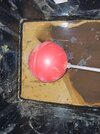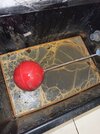Last autumn, I cleaned out the central heating system (old back boiler with F&E) with X400, and dosed with X100. It hadn't been touched for a good few years prior to that. A few months later, I find this gunge in the tank (stringy/white stuff) which Google tells me is probably bacterial and caused by the inhibitor. I baled out most of it but it came back quickly.
I am not sure what to do now. It looks like a good option would be to bale out the tank, hoover it dry, wipe with bleach and add some kind of biocide. But I can only see a few biocides in SF/Wickes/Toolstation, and they're all made for underfloor systems. What should I do, and why are biocides for my problem unavailable in the big plumbers merchants (which makes me think either my problem is rare or the chemicals don't work for it)?


I am not sure what to do now. It looks like a good option would be to bale out the tank, hoover it dry, wipe with bleach and add some kind of biocide. But I can only see a few biocides in SF/Wickes/Toolstation, and they're all made for underfloor systems. What should I do, and why are biocides for my problem unavailable in the big plumbers merchants (which makes me think either my problem is rare or the chemicals don't work for it)?



